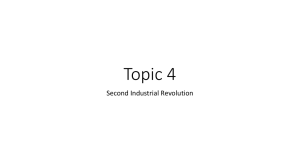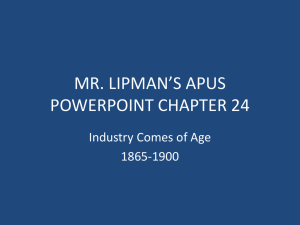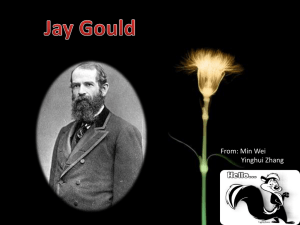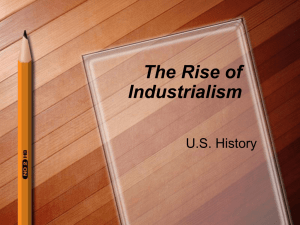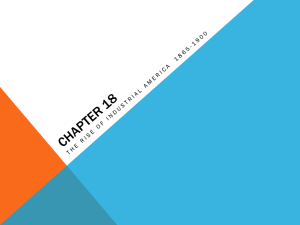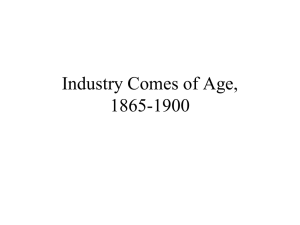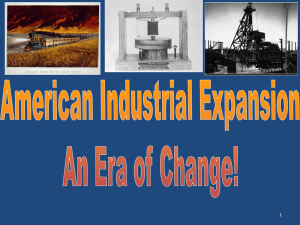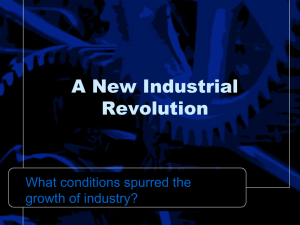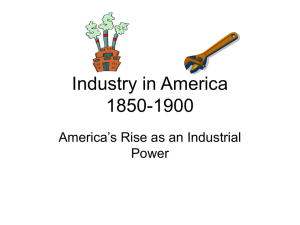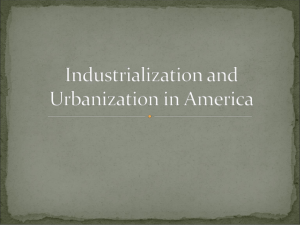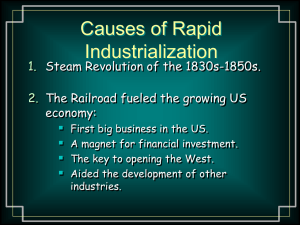chapter18 outline The Rise of Industrial America
advertisement
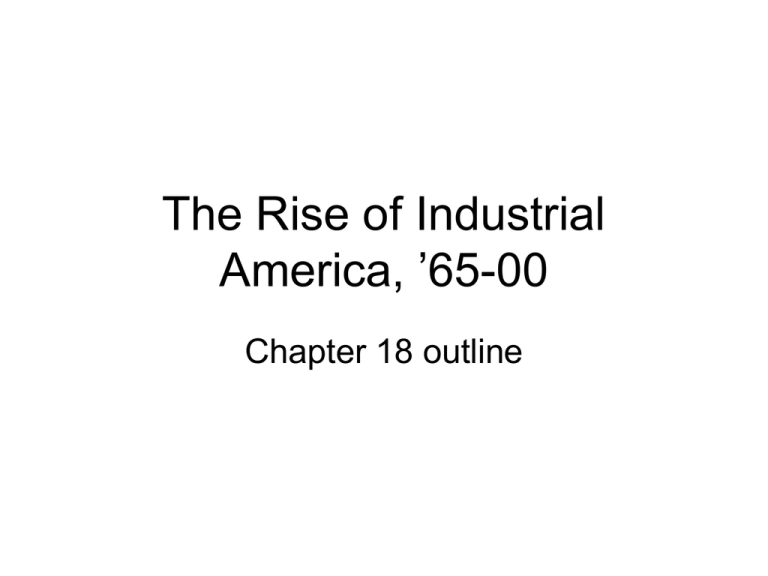
The Rise of Industrial America, ’65-00 Chapter 18 outline 5 Major themes • Innovative tech. & bus. Practice changed production • Monopoly of industries by bus. Leaders • Why was industrialization in the S. differ from the N. & Midwest • Workers’ response to work & growth of corporations • The tactics used by corporate executives to undercut labor’s bargaining power Character of Industrial Change 1. Coal deposits as cheap energy • • 2. Innovative transportation, communication, & factory systems Need for enormous numbers of workers 3. • 4. Tech. enables cost cutting & hiring cheap unskilled & semiskilled Intense competition led to cutting costs & prices and to monopolies • • 5. 6. PA, WV, KT Fueled railroad, factories, & urban growth Cost cutting led to ruthless elimination of competition Colossal fortune at the top but suffering of working class Relentless drop in prices Failure of the money supply to keep pace w/ productivity, which drove up interest rates & restricted the availability of credit Railroad innovation • Most intense competition among railroads • By 1900, US had more miles (193,000) than all of Europe’s, including Russia’s • Railroads changed corporate enterprise culture by…. • Issued stock & bonds for huge capital needs – Borrowed heavily & had to appeal for generous land & loan subsidies fr. fed., state, & local gov’t – Interest repayments cut heavily into earnings – Collis P. Huntington = Central Pacific Railroad – Jay Gould = Union Pacific – James Hill = Northern Pacific • Separation of ownership from management’ • Nat’l distribution & marketing: – relied on magnetic telegraphs • New organizational & managerial structures – Hierarchical, separate geographic units – Elaborate accounting & reports: set rates & predict profits Consolidating the Railroad Industry • Huntington, Gould, & others killed hodgepodge of smaller railroad companies: financed by eastern & British banks • Created integrated track (4’81/2” gauge) networks; standardized basic equipments/facilities • Corrected delay problems by divided country into 4 time zones • Uniform rates nationwide • Railroad leaders depicted as robber barons & villains (Chapter 18) Abusive Monopoly Power: Cartoon from Puck Magazine Jay Gould (1836-92) was one of the wiliest financial entrepreneurs on Wall Street. In 1868 he bribed the New York legislature to defeat Cornelius (Comodore) Vanderbilt and gain control of the Erie Railroad. In 1869, with the flamboyant Jay Fisk, he had tried to corner the gold supply and control the currency. In the next decade, despite his public image, in the words of Maury Klein, his recent biographer, as a “deadly and elusive predator,” Gould took advantage of the cutthroat railroad competition to take control of the Union Pacific, the Kansas Pacific, the Wabash, the Michigan Central, and the Canadian Southern railroads. He eventually even controlled the elevated railway system in New York City. At the same time, recognizing the value in emerging telegraphic communications industry, Gould gained control of Western Union, undersea cable connections, the Associated Press, and several leading newspapers. Western Union and its competitor, the Atlantic and Pacific Telegraph Company, which Gould also controlled, dominated telegraph transmission of the news nationwide. Rival newspapers lambasted him as an evil wizard out to control society itself. 1. Why is the image of Uncle Sam tied to a telegraph pole so powerful? What other images does it bring to mind? Why are the ropes around him labeled N.Y. World, N.Y. Tribune, and [N.Y.] Evening Express? 2. Why are the telegraph lines depicted as snakes? What is the decoration on them? (Chapter 18) 1. Why is the image of Uncle Sam tied Cartoon from to a telegraph pole so powerful? What other images does it bring to Puck mind? Magazine Why are the ropes around him labeled N.Y. World, N.Y. Tribune, and [N.Y.] Evening Express? 2. Why are the telegraph lines depicted as snakes? What is the decoration on them? Bad side of consolidation Debt, overextended systems, crooked bus. Practices led to reckless cost cutting for traffic • Favored kickbacks & rebates to special clients • Free passes for politians • Special rates for larger shippers • Hurt small farmers & businesses: turned to state gov’t for help – Supreme Court in 80s ruled that states could not regulate interstate commerce – But passed Interstate Commerce Act in ’87 & 5-member ICC (Interstate Commerce Commission) was est. • Banned monopolies among other laws • Railroads challenged ICC in 16 cases before ’05 & won all, but one, but then Hepburn Act in ’06 empowered ICC to set rates • Competition abated when depression hit in 1893 – Railroads in the hands of JP Morgan & other investment bankers – JP reorganized their systems & refinanced their debts Applying lessons of Railroad to Steel Andrew Carnagie fr. Scottland, came to US in ’48 • "I don't believe in God. My god is patriotism. Teach a man to be a good citizen and you have solved the problem of life." ~ Andrew Carnegie • Worked as bobbin boy $1.20/wk (60hrs) • Messenger boy to telegraph operator – – – – – Hired then by Tom Scott of PA Railroad Became of head of company’s western division at age 24 Used complex cost analysis to cut cost & increase traffic Earned $56,000 yr fr. Investment in the railroads Built his own steel mill in 70’s & used Henry Bessemer method; knew actual production cost of each ton of steel due to his cost analysis. Figure 18.1: Iron and Steel Production, 1875–1915 Figure 18.2: Mergers in Mining and Manufacturing, 1895–1910 Figure 18.2: Mergers in Mining and Manufacturing, 1895–1910 (cont’d) Railroad to Steel: Carnegie • Lower production cost by limiting wage increases • Discovered vertical integration: fr. Mining & smelting of ore to selling the steel • Philanthropic activities: gave more than $300 M to libraries, uni., & int’l peace causes • Carnegie Steel = world’s largest industrial corporation by 1900 • Consolidation of Carnegie w/ Federal Steel = 1st business capitalized at more than $1b • The Trust: Creating New Forms of Corporate Organization Industries like oil, salt, sugar, tobacco, meapacking followed cost cutting method • Philip Armour & Gustavus Swift (Chicago) raised efficiency of using every part of cattle • Edwin Drake drilled 1st crude oil in ’59 in PA: distilled into kerosene…oil in rivers • John D. Rockefeller fr. Cleveland also into cost cutting & efficiency – – – – Head of Standard Oil Company in ’73; also used vertical integration Also aggressively forced out competitors By’79 he seized 90% of US ‘s oil-refinering capacity Est. the Standard Oil Trust to eliminate competition • Verbal agreement among groups of companies to controll prices & markets – Oligopoly – By merging competing companies into a giant, he also used horizontal integration The Trust: denounced by gov’t • Sen. John Sherman (OH): passed Sherman Anti-Trust Act in ’90 – Outlawed trusts & other monopolies: fines up to $5000 & 1 yr. in jail – Failed to define “trust” or “restraint of trade” – Corporate lawyers simply organized trusts into holding company, which owns a share of stock of more or more firms, which makes money as well – Supreme Court sympathized win big bus: hamstrung Congress • US v. EC Knight Company …favored company by ruling that manufacturing was not interstate commerce Economic Growth: Tech • New inventions stimulated consumer demand • Example: Safe electricity led to electrical motors, appliances, & lightning systems • Bonsack machine rolled 120TH cigarettes a day, replaced 60 skilled handworkers • Success of Singer sewing machine ’60s – Innovative use of interch. Parts + advertising campaigns – Mass produced cloth= expanded wardrobe • Phone: Alex. Graham Bell ’76 • Light bulb: Thomas Edison ‘79 Economic Growth: Edison • Edison had little edu, like A. Carnegie • He studied Thomas Paine's Age of Reason before he was 12, and “recognized no power greater than Nature” • Earlier work: telegraph, stock quotation printer, phonograph or “sound writer” • Light bulb: – had to be easy to repair/install – More convenient than gas or kerosene lighting • Merged w/ competitor to form GE ’92 • Westinghouse & GE exchanged patents: – Patent-pooling as mechanism for market domination • Later inventions: mimeograph, microphone, motionpicture camera & film, storage battery • Died in 1931: had patented 1,093 inventions Economic Growth: Custom-made • Philadel.’s Baldwin Locomotive Works – Employed 2TH workers; made 900 engines/yr – Each machine was custome designed; no standardization • Women’s apparel: most was custom produced until 1900 – Dressmakers & milliners (fancy goods vendors) paid high wages to skilled seamstresses – Shift styles quickly to follow fashion Economic Growth: Ad. & Marketing • Flour industry shows mass production & marketing concepts • Output exceeds market demands – Excess led mills to create new products: cake flours, breakfast cereals (Quaker Oats) • Marketing for consumer loyalty: brand names, trademarks, guarantees, slogans, endorsements, & other gimmicks – Ivory soap (Proctor & Gamble) ’79: “99 and 44/100 pure” – Cigarettes: James “Buck” Duke used trading cards, circulars, box-top premiums, prizes, testimonials, & scientific endorsements – Campbell soup ad ’90: as good as gourmet food • Kodak camera “you push the button, we do the rest” – Market: customers return film & camera, factory developed, printed, reload & shipped back …all for $10 – Revolutionized industry & democratize a visual medium Economic Growth: Costs & Benefits • Industrial competition led to many bankrupted co. • Also high costs for US workers: immigrants & natives – Subsistence wages & could be fired on moment’s notice • Devastated the environment: chemical waste, garbage, pollution • Benefits: labor-saving products, lower prices, advances in communication & transportation • Benefits & liability sometimes interconnected: – Ex: sewing machine • • • • created thousands of new jobs Wider variety of clothes Eased the lives of millions of housewives Young women toiled long hours in sweatshops for pitifully low wages The New South: economically weak • • • • • • • war’s physical devastation few towns/cities lack of capital Illiteracy northern control of financial markets & patents low rate of tech. innovations nostalgia for pre-war era… perpetuated image of the South as traditional & unchanging The New South: lack capital as Obstacles to Progress • By ’65 had only 2% of nation’s banks – Fed policies made banking difficult: $50Th required to start a bank – Merchants/storekeepers lend supplies in lieu of cash in return for crops; farmers in debt & grew only cash crops (tobacco & cotton) to repay; short labor for industry – Cash crops: farmers vulnerable to fluctuations of commercial agriculture • Cotton 11c/lb in ’75 to 5c/lb in ’94 • High tariffs made imported machines expensive to farmers • Demonetization of silver limited capital availability • Discriminatory freight rates hiked expense of shipping The New South: lack education • • • • Limited resources reduced education Operated segregated schools Refused to tax property to fund schools until ’89 School attendance remained low; limited educated work force • Built white patronage system by modest funds to veterans – Reinforce “old south’ idea: Lost Cause – 1911 veterans’ pensions ate 22% of GA’s state budget – Leaves little for educational & economic developm. The New South Creed & Industrialization • The New South creed: doctrine created by newspaper (Henry Grady & Henry Watterson) that the South is the El Dorado for the next half century • Industrialization gained momentum in 80s – Offered tax exemptions, leased prison convicts to serve as cheap labor, gave huge tracts of lands to railroads • Southern iron & steel mills as large scale recruiters if black workers – 1900, black population in urban = 20% – 60% work force = black; but no chance of advancement – Southern blacks in iron/steel earned more than whites in textile • Segregation: black women cleaned tobacco leaves, white women ran machines that made cigarettes The Southern Mill Economy • Textile mills as catalyst for new towns (like NE in 1820’s) – Largely in Piedmond: central VA to GA to AL – Towns increased due to railroad – 1920 the South was leading nation in textile-mill • Poor black & white tenant farmers still vulnerable to exploitations by merchants, lawyers, doctors, & bankers – Commercial agriculture – Paid workers 30-50% less than in NE – Built & owned workers’ housing, company store, supported church, financed elem. School – Prevent movement of workers: paid once/mo in script • Certificate redeemable only in goods from company store – Families in debt cycles like tenants & sharecroppers – Whole family worked: bring babies along The Southern industrial lag • Southern industrialization compared to the N. – Smaller scale & slower rate – Depended far more in outside financing, tech., & expertise • Ex: steel was more expensive for southerners to buy – US Steel executives priced steel based in Pittsburg: Factories & the Work Force: Fr. Workshop to factory • Transition to factory economy evident by boot/shoe industry • Shoes still custom made in 1840s; shoemakers had high status • Ready-made shoe market eroded status – Skilled shoe artisans now work as team of 4, reach w/ one function – Lost freedom to drink on the job or take time off for special occasion – Working class culture now viewed as wasteful/inefficeint • Large factories grew; traditional skills vanished – Replaced by lower paid, less skilled Factories & the Work Force: hardships of industrial labor • Factory system increased = unprecedented demand for unskilled labor • Contract system: subcontractor responsible for managing gangs of laborers – Seasonal & transient, laid off when not needed – Unskilled; pushed hard by foreman/boss “pushers” • ’70s skilled ones earned $3/day; unskilled $1.30 • Industrial accidents: – Dangerous working conditions – Inexperience – rapid pace of production process • Child labor: starts at age 8 or 9 – Coal mine = black lung disease leads to tuberculosis & emphysema Factories & the Work Force: immigrant labor • Unskilled immigrant labor for heavy construction industries, mills, railroads… • Philadelphia: – skilled dominated by native born & German immigrants – Unskilled by Irish until ’90s when replaced by eastern & southern Europeans (“new immigrants”) • Northeast: poor French-Canadians in textile mill • West Coast: Chinese in mining, canning, railroad • Immigrants must adjust from farm pace to production pace – Factory owners’ tactic: temperance societies, Sunday schools to teach punctuality & sobriety – Gain leverage by offering low cost housing; strike= evicted – Used “race” concept on darker Europeans: Irish, Greek, Italian, Jewish, & others • Non-white; didn’t deserve same compensation as white Factories & the Work Force: Women & work Women’s work experiences • White married women of all classes accepted “separate spheres” & remained at home • Working class: needed extra income & earned wages at home – Sewing, button-making, taking in boarders, & doing laundry – Exploited by entrepreneurs: lease tenements in return for long work hours in apartments • Cigar manufacturers • Single women preferred working in textile rather than domestic work to avoid being a “servant” – Except black women due to discrimination – Low pay: $5/70hours • 1900 female comprise 17% of nation’s work force • Typewriter & telephone led to new job opportunity – Typist paid $6-8/wk; steadier & more prestige Factories & the Work Force: hard work & gospel of success • Horatio Alger: Unitarian minister turned dime novelist – ’67 Ragged Dick: praised poor, honest lads rose through ambition & self-discipline – Andrew Carnegie inspired “rags to riches” • Mark Twain chided public for naiveté – Essay in ’71: business success likely on lies & cheats – His ideas reflected by Thomas McGuire’s testimony of destitution & tenement life • Facts: 95% of industrial leaders came fr. Middle- & upper-class backgrounds • Advancements were limited due to discrimination; exception = Donahue brothers wealthy fr. Union Iron Works • Native born whites advantage: higher education & family financial backing • Positives: real wages rose 31% for unskilled & 74% for skilled; middle class enlarged • Neg: purchasing power undercut by injuries & lay off; gap between the poor & well-offs Mark Twain: ordered his uncensored book not to publish until 100 years after his death • A God who could make good children as easily a bad, yet preferred to make bad ones; who could have made every one of them happy, yet never made a single happy one; who made them prize their bitter life, yet stingily cut it short; who gave his angels eternal happiness unearned, yet required his other children to earn it; who gave is angels painless lives, yet cursed his other children with biting miseries and maladies of mind and body; who mouths justice, and invented hell -- mouths mercy, and invented hell -- mouths Golden Rules and foregiveness multiplied by seventy times seven, and invented hell; who mouths morals to other people, and has none himself; who frowns upon crimes, yet commits them all; who created man without invitation, then tries to shuffle the responsibility for man's acts upon man, instead of honorably placing it where it belongs, upon himself; and finally, with altogether divine obtuseness, invites his poor abused slave to worship him! 4/13/2015 AP Planning 34 Labor Union & Industrial Conflict • Labor leaders sought to organize national to protect workers & resist corporate power Labor movement challenge: • Ethnic & racial divisions • Skilled & unskilled division • Different trades; lack unity Nat’l Labor Union & Knights of Labor • Tried to unite workers regardless of specialties • Efforts collapsed American Federation of Labor (AFL): • More success; represented amalgamation of powerful craft unions • But small portion of nation’s total labor force Crisis that shaped US’s legal environment, state laws, & progressive reform • strike & violence out of intolerable conditions Organizing the Workers • William Sylvis organized Iron Molders’ Int’l Union & renamed it Nat’l Labor Union (NLU) – Name change to include all workers’ – 8 hr/day – End convict labor – Est. federal department of labor – Currency & banking reforms – Endorsed restriction of immigrants; particularly Chinese (blamed for undercut wage level) – Supported cause of working women; elected a woman as nat’l officers – Urged blacks to organized; although segregated racial unions • Sylvis died in ’69, NLU vanished Organizing the Workers: Knights of Labor Founded by Uriah Stephens & other taylors in ’69 • in Phila • Named the Noble and Holy Order of the Knights of Labor • Secret society like the Masonic order • Included all wage earners; excluded bankers, doctors, lawyers, gamblers, liquor dealers • Called to end convict & child labor • Equal pay for women • Graduated income tax (no fed. Income yet) • Cooperative employer/employee ownership of factories, mines, & other business Organizing the Workers: Knights of Labor Membership skyrocketed after Terence Powderly replaced Stephens in ’80s • Apposed strikes & urged temperence • Welcomed women (10% membership) & blacks (allowed segregated unions in South) – Mary Jones = Mother Jones • Total ban on Chinese immigration • Riots against Chinese in CA: workers destroyed Chinese-run laundries & terrorized Chinese population • 1900 gov’t passed Chinese Exclusion Act & made permanent in 1902 • Struck against Wabash railroad (Jay Gould) & succeeded & membership soared by ’86 • Unauthorized strikes failed in ’86 – Haymarket riot contributed to decline of union Organizing the Workers: AFL • Union crafts broke off fr. Knights of Labor to form AFL • American Federation of Labor, AFL, led by Samuel Gompers Gompers led from ’86 to 1924 • immigrant cigar maker • Raising wages & reducing work hours • Liabilities for injuries & mine safety laws • Federation by allowing various trade unions to be independent by tied to nat’l organization • Believed women belonged in the home • Grew 1.6 million members by 1904 Yet labor organization remained weak; only 5% of workforce joined union Organizing the Workers: strikes & Violence • 37TH strikes erupted fr. 1873-1905 • 1877 deadly strike sparked by wage reduction – Strike exploded along rail line spreading to NY, Pittsburgh, St. Louis, Kansas City, Chicago, & San Francisco – New Pres. Rutherford Hayess called troops to quell it – 100 people died; 2/3 nations’ railroads stood idle • Middle class terrified of mob violence & employers capitalized on hysteria – Forced workers to sign yellow dog contracts • Promise not to strike – Hired Pinkerton agents as their own private police force – Turned to fed. Army & US army to suppress labor unrest • ’86 Haymarket: a bomb thrown killing 7 policemen & police fired into crowd killing 4 protestors – 8 men arrested; 4 of these executed although no evidence – Animosity towards unions intensified • Pullman Palace Car Co. ’94 strike: George Pullman slashed wage w/out reducing rent (nice planned community) – Eugene Debs led union to strike & paralyzed Chicago, the hub – Debs was arrested & fed troops poured in • 700 rail cars burned, 13 died, 53 wounded • Corporate leaders played unions as anarchist & violent • Fed. & state gov’t sided with employers & hamstrung labor’s efforts • Ended up weak w/ negative image up to 1930s Organizing the Workers: Alternatives • Walt Whitman observed the spread of the poor • Laissey Faire advocates cited Adam Smith’s the Wealth of Nations (’1776) – Andrew Carnegie justified laissez faire by citing Charles Darwin’s evolutionary theories “survival of the fittest” by ignoring the practice of monopoly earlier by praising unregulated environment as beneficial – William G. Sumner, professor, also shared disapproval of gov’t interference – Conservative social brand = Social Darwinism • Lest F. Ward claimed that gov’t could regulate bus., protect society’s weaker members, & prevent exploitation of natural resources • Henry George proposed single tax & state controlled ecnomy to distribute wealth evenly • Edward Bellamy wrote utopian novel ’88: state-run; equal,conflict free society • These 3 sought to humanize industrialization • Karl Marx in Das Kapital envisioned a class struggle to form a classless society: Bourgeosie v. proletariat (Chapter 18) World’s Fair Poster This poster for the 1893 Chicago World’s Fair makes specific reference to Chicago Day, October 9th, the anniversary of the Fire. The reference harks back to the great fire of 1871. Chicago at the time had 330,000 inhabitants and was the fourth largest city in the nation. The fire had swept over nearly 2,000 acres of the city, destroying 18,000 buildings, or nearly one-third of the city. 100,000 people lost their homes. Thus, the reference to the Chicago fire contrasts the marvelous white city of the Fair to the ruins that had existed a scant thirty-two years earlier. Built on a swamp, with interior lagoons, electric lights, and even its own heating plant, the White City was testimony to the regeneration of Chicago and the power of planning and technological innovation. The poster shows the massive Manufactures and Liberal Arts building in the upper half and the stately Court of Honor in the lower section. The uniform building height and the classical revival architecture in the Court of Honor created a sense of monumentality and grandeur. It also implicitly announced that Chicago and the United States had become a world power, much as Rome had been in the ancient world. The pageantry, evening parades, and “the Grand Reunion of the States by Youths and Maidens” announced to all that the U.S. had overcome its internal divisions and stood poised for international greatness. 1. Why is it significant that manufacturing and the liberal arts were grouped together in the largest building at the fair? 2. Why would the city of Chicago want to celebrate the anniversary of the fire? 3. What purpose do the parades play? Why does the poster boast that these events will be “the most Significant and grandest special of Modern Times?” 1. Why is it significant that manufacturing and the liberal arts were grouped together in the largest building at the fair? 2. Why would the city of Chicago want to (Chapter 18) celebrate the anniversary of the fire? What purpose do the parades play? Why World’s Fair Poster does the poster boast that these events will 3. be “the most Significant and grandest special of Modern Times?”
